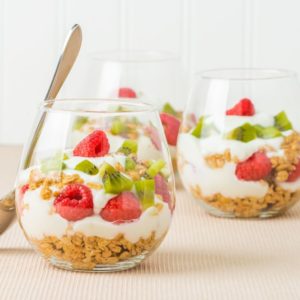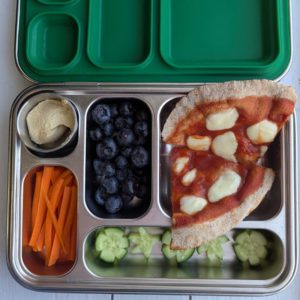
Is your child getting enough fiber? Learn how much fiber your kids need per day, and which foods are highest in this plant-based nutrient!
Does your child’s plate lack a variety of colors? Does your kid often have trouble going number two or takes f-o-r-e-v-e-r? If the answer to any of these questions is “yes,” your child may not be getting enough fiber each day. Learn the recommendations for daily fiber intake for kids from ages one to eighteen and gain insights into easy swaps to boost fiber onto your kid’s plate!
What is fiber?
Fiber is a carbohydrate that our bodies cannot digest. There are two main types of fiber, soluble and insoluble, both which are beneficial to our health. You can read more about fiber and the benefits of both soluble and insoluble fibers here. Fiber is found in plant-based foods.
Eat the rainbow! It’s a phrase that’s often used to encourage kids to eat a variety of fruits, vegetables, and other plant-based foods. Foods with fiber have vitamins, minerals, plant compounds, and more. But, where there is color, there is also fiber! They are just like two peas in a pod. So, get a “two-for-one” on nutrition by including foods such as fruit, vegetables, grains, legumes, nuts, and seeds. (1) Your child’s plate will look like one of their art projects, and be filled with an abundance of health benefits.
Meeting Fiber Needs
If fiber is in many whole foods, children must be getting a TON of it. Right? Actually, most children don’t get nearly enough fiber, according to the current recommendations. For children ages 2 to 5 years of age, the average fiber intake is about 11 grams per day. For children 6 to 11 years, the average fiber intake is about 14 grams per day. For ages 12-19, the average for boys is 16g and for girls 13g. (2) But, what if you knew that children need twice the fiber that they’re currently eating!
So how do you know how much fiber your child needs to meet the recommended daily fiber intake? It depends on their age. A general rule of thumb is your child’s age plus 5 grams or 0.5 g fiber/kilogram of body weight, or up to 35 grams/day to the age of 18.
Daily Fiber Intake Recommendations for Kids Ages 1-18
The Dietary Reference Intakes (DRI) provides the following recommendations: (3)
- Children 1-3 years: 19 grams of fiber per day
- Typically, for children under 2 years, there is no recommendation for total fiber. Just make sure to provide a variety of fruits, vegetables, beans, and whole grains as you introduce solid foods.
- Children 4-8 years: 25 grams of fiber per day
- Boys 9-13 years: 31 grams of fiber per day
- Girls 9-13 years: 26 grams of fiber per day
- Boys 14-18: 38 grams of fiber per day (3)
- Girls 14-18: 26 grams of fiber per day (3)
Once adolescents reach nineteen years of age, the recommendation is 25-38 grams per day (or about 10-13 grams per 1000 calories) as for all adults. (3) If these recommendations for daily fiber intake seem a bit daunting, see our 20 fun ways to boost fiber intake or try one of our food swaps to boost fiber below!
High Fiber Foods for Kids
High fiber foods include whole fruits and vegetables, whole grains, legumes, nuts, and seeds. (4) To give you an idea of how much fiber is in food, take a look at the following list:
- ½ cup of beans or legumes = 6 grams of fiber
- ½ cup of cooked vegetables = 2 – 4 grams of fiber
- ½ cup of chopped fruit or 1 small piece of fruit = 3 grams of fiber
- 1 slice of white bread = 0.5-1 gram of fiber
- 1 slice of whole wheat bread = 2 – 4 grams of fiber*
- One slice of whole wheat bread has 100-800% more fiber than the same slice of white bread!
- ½ cup of whole grain cereal = 5 grams of fiber
- ½ cup of cooked regular pasta = less than 1 gram of fiber
- ½ cup whole grain pasta = 2 – 4 grams of fiber
- Whole grain pasta has 100-400% more fiber than the same amount of regular pasta!
- ½ cup of cooked white rice = less than 1 gram of fiber
- ½ cup of cooked brown rice = 2 grams of fiber
- This is 100% more fiber than the same amount of white rice!
- ½ cup of fresh or frozen raspberries= 7 grams of fiber
* When selecting a loaf of bread at the grocery store, compare labels and choose bread with higher fiber.
Introducing High Fiber Foods for Kids
Make sure to introduce fiber slowly and drink plenty of water to prevent any undesirable side effects. Your child’s body will get used to the extra fiber over time. Read 6 Ways to Boost Fiber to help your child increase their daily fiber intake without stomach discomfort!
Food Swaps to Boost Fiber
Help your kid meet their daily fiber intake with these simple food swaps incorporating great high fiber foods for kids! It’s time to get creative and help prevent poor fiber intake.
Breakfast
| Original Choice | Replace With |
| Cereal with milk | Oatmeal made with 0-2% milk + a handful of blueberries & walnutsORA high-fiber cereal with 0-2% milk + a handful of blueberries*Helpful tip: choose a cereal that lists whole grain as the first ingredient in the ingredient list, and has less than 5g of added sugar per serving at least 4 gram of fiber. |
| Regular waffles with syrup | Whole grain waffles + a spoonful or two of low-fat plain yogurt + a handful of raspberries |
| Scrambled eggs with 2 pieces of French bread | Scrambled eggs with spinach, tomato and onion with a whole wheat English muffin and healthy butter substitute |
Lunch
| Original Choice | Replace With |
| PB & J sandwich | Open PB & J on whole-wheat bread and with banana slices and crushed nuts |
| Turkey wrap on flour wrap | Turkey, spinach, tomato, avocado, with hummus on a whole-wheat, brown rice, or cauliflower wrap |
| Grilled cheese | Grilled cheese with tomato and kale on whole-grain bread |
| Burrito with white rice, chicken and cheese | Brown rice bowl with chicken, broccoli, carrots and black beans |
Snacks
| Original Choice | Replace With |
| Low-fiber energy bar | Trail mix with mixed nuts (walnuts, almonds & cashews), dried fruit (raisins, craisins, goji berries) seeds (sunflower, pumpkin), and handful of dark chocolate pieces |
| Orange juice | Whole orange + handful of mixed nuts |
| Apple sauce | Whole apple with skin(minus the core!) + 2 tablespoons of almond butter |
| Chewy fruit snacks | Grapes |
| Chips & salsa | Baby carrots (or other raw vegetables) & a black bean dip or hummus |
Dinner
| Original Choice | Replace With |
| Turkey burger with regular white bun and French fries | Turkey burgers made with half mushroom. Or a high fiber plant-based burger with a whole-grain bun, lettuce, tomato, avocado & a side of roasted sweet potato wedges |
| Regular white pasta with butter | Whole-wheat or chickpea pasta with eggplant, zucchini, and diced tomatoes |
| Chili | Fava bean, lentil, spinach and carrot soup |
References
- Harvard Health Publishing. Surprising sources of dietary fiber. Harvard Health Publishing, Harvard Medical School. https://www.health.harvard.edu/staying-healthy/surprising-sources-of-dietary-fiber. Published December 2017. Accessed February 5, 2020.
- Hoy MK and Goldman JD. Fiber intake of the U.S. population, What We Eat in America, NHANES 2009-2010. Food Surveys Research Group Dietary Data Brief No. 12. September 2014. Accessed March 12, 2020. https://www.ars.usda.gov/ARSUserFiles/80400530/pdf/DBrief/12_fiber_intake_0910.pdf
- Institute of Medicine of the National Academies. Dietary Reference Intakes for Energy, Carbohydrate, Fiber, Fat, Fatty Acids, Cholesterol, Protein, and Amino Acids. National Academies Press: OpenBook. https://www.nap.edu/read/10490/chapter/32#1324. Published 2002. Accessed February 5, 2020.
- Harvard T.H. Chan School of Public Health. Fiber. The Nutrition Source. https://www.hsph.harvard.edu/nutritionsource/carbohydrates/fiber/. Published October 28, 2019. Accessed February 5, 2020.












